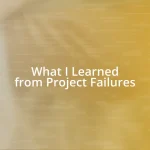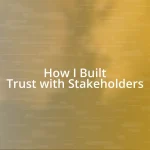Key takeaways:
- Stakeholder engagement is crucial; it’s about listening and understanding community needs, not just fulfilling a checklist.
- Data collection should include both quantitative metrics and qualitative insights, emphasizing the importance of human stories behind the statistics.
- Recommendations must be actionable and adaptable, fostering collaboration and ongoing dialogue with the community they aim to serve.

Understanding Impact Assessment Process
Understanding the impact assessment process is crucial for evaluating projects effectively. I still remember my first time diving into this process; it felt like opening a door to a new world filled with possibilities and responsibilities. Have you ever wondered how your decisions ripple through a community? That’s precisely what an impact assessment seeks to uncover.
At its core, the process involves identifying the potential effects of a project—both positive and negative. I recall sitting in a meeting with my team, realizing we needed to account for concerns from local stakeholders. Engaging in heartfelt discussions about the potential outcomes deepened my appreciation for the complexities involved. It wasn’t just about numbers; it was about lives, livelihoods, and the broader community context.
As I navigated through each step, it became evident that stakeholder engagement is not merely a checkbox on a list. I sometimes found myself feeling overwhelmed by the responsibility to capture diverse voices effectively. Reflecting on this journey, I’ve learned that listening is just as vital as analysis. The insights we gain from those conversations can profoundly shape the decisions we make.

Preparing for the Impact Assessment
Before diving into the impact assessment, it’s essential to gather your resources and clarify your objectives. I vividly remember the time I spent sifting through previous project reports and stakeholder feedback. It felt a bit like piecing together a puzzle, where each piece provided a hint—an insight—that shaped my understanding of what the assessment would entail. Knowing precisely what I wanted to achieve made the process smoother and more focused.
- Define clear objectives for the assessment.
- Gather relevant documentation from past projects.
- Identify key stakeholders and their potential interests.
- Determine the methods for data collection and analysis.
- Schedule meetings to discuss preliminary concerns with stakeholders.
Connecting with stakeholders before the assessment is equally important. I still recall how a casual conversation over coffee with a community leader opened my eyes to issues I had never considered. Their stories humanized the data and highlighted the real-world implications of our project. This personal engagement not only enriched my understanding but also fostered trust, which is indispensable for impactful assessments.
- Conduct informal interviews to build rapport.
- Create dialogue sessions for collective brainstorming.
- Involve stakeholders in setting the agenda for the assessment.
- Encourage openness by sharing your own experiences and challenges.
- Be receptive to feedback—not just during the assessment, but continually throughout the process.

Identifying Key Stakeholders Involved
Identifying key stakeholders is a crucial step I learned during my first impact assessment. I remember spending hours mapping out who would truly be affected by our project. The team and I created a list that included everyone from local community members to city officials. Each group had unique perspectives, and understanding their interests opened my eyes to the diverse fabric of that community. It became clear how vital it was to include voices from all corners, as each one played a role in shaping the project’s path.
I found that just listing stakeholders wasn’t enough; it required a deeper connection. One afternoon, I attended a community event intending to engage with residents. Listening to their stories made me realize how often projects overlook the people they directly impact. For instance, one elder shared her experience about past development plans that neglected local traditions. Her wisdom influenced how we framed our discussions later. That’s why I believe establishing genuine relationships is critical to capturing insights that statistics simply can’t convey.
As my understanding of stakeholder dynamics grew, I saw the value of prioritizing those who would be most affected. A comparison emerged between those who held decision-making power and those whose lives the decisions impacted. Understanding this balance was essential. Therefore, categorizing stakeholders by influence and interest helped streamline our engagement strategy. This practical approach ensured we could focus our resources efficiently.
| Stakeholder Type | Engagement Strategy |
|---|---|
| Community Members | In-person interviews and community meetings |
| Local Government Officials | Formal presentations and consultations |
| Non-profit Organizations | Collaborative workshops and brainstorming sessions |

Collecting Relevant Data and Information
Collecting relevant data and information can feel overwhelming, but I found it more manageable by breaking it down into smaller steps. I began with quantitative data, like project metrics and demographic statistics. But then I realized, without qualitative insights, the numbers didn’t tell the whole story. How could I accurately assess the impact without understanding the lived experiences behind those figures?
To gather qualitative data, I turned to storytelling. One memorable instance was a focus group I organized with local youth. Listening to their aspirations and concerns gave me a new perspective. Their insights provided a vivid context that no chart could convey, reminding me of the importance of capturing human experiences. It raised the question: how do we ensure that our data reflects not just what’s happening, but the why behind it?
Ultimately, I realized that revisiting the data collection phase is vital. I would often revisit previous findings as new insights emerged, ensuring my assessment evolved as much as the project itself. This iterative approach made me appreciate that collecting data isn’t a one-time task but an ongoing journey. As I dug deeper, I gained a richer understanding of the community’s needs and the nuance of their experiences—an invaluable asset for any meaningful impact assessment.

Analyzing Potential Impacts and Outcomes
During my analysis of potential impacts and outcomes, I quickly realized that predicting the effects of a project isn’t just about numbers and projections—it’s about understanding stories. I remember a particular moment during a discussion with a community leader when she expressed her fears about the changes our project might bring. Her emotions were tangible, revealing the unwritten narrative behind the statistics. This experience taught me that emotional insights play a pivotal role in refining impact assessments. How can we expect to implement positive change if we don’t address these deeper feelings?
As I delved into different scenarios, I could almost visualize the ripple effects of our initiatives. For example, I compared what would happen if we implemented a community garden versus a large commercial development. The garden could foster connection and collaboration among residents, while the commercial development might heighten tensions around displacement. It was a stark contrast that made me rethink priorities. Isn’t it interesting how one decision can lead us down paths we never anticipated?
Reflecting on all these potential impacts led to a valuable lesson about adaptability. I learned that an effective impact assessment needed to be fluid, evolving as new insights emerged. It felt like sculpting in clay, where each twist of the wrist could reshape the entire outcome. I often asked myself if we could remain open to changing our course if the assessments indicated a different direction was necessary. That’s when I realized that resilience and flexibility are just as crucial as the analysis itself in creating meaningful outcomes.

Making Recommendations for Action
When it came time to make recommendations for action, I reflected on the data I had gathered and the stories I had heard. In one meeting, a passionate participant expressed how our project could significantly uplift local artists. This sparked an idea: why not establish a grant program to support their work? Listening to the community’s needs instilled a sense of responsibility in me. It made me realize that our recommendations should not just come from a place of analysis—they must resonate with the aspirations of those we aim to serve.
As I put together my recommendations, I prioritized creating actionable steps that were not only impactful but also realistic. It was a balancing act, much like navigating a tightrope. For instance, in considering the challenges of a local environment initiative, I suggested starting with smaller, pilot projects that could gather momentum before scaling up. I found that breaking larger goals into bite-sized chunks helps to build interest and ensures buy-in from stakeholders. But isn’t it crucial that we recognize the human element behind every recommendation? Each step forward ought to connect directly with the community’s needs, making our proposals relatable and attainable.
Ultimately, I understood that effective recommendations must also include mechanisms for feedback and adaptation. After presenting my action plan, I felt a mix of excitement and apprehension. How would people respond? Would they feel empowered to take ownership? I realized that fostering a culture of collaboration meant encouraging ongoing dialogue. In this way, I viewed my recommendations as living documents—open to adjustments as we learned from our experiences together. Don’t you think it’s essential to create a dynamic space where community voices shape the journey ahead? This mindset transformed the way I approached recommendations, turning them into a collaborative guide rather than a rigid roadmap.

Reporting Findings and Next Steps
Once I gathered and analyzed the findings, the next step was reporting them back to stakeholders. When I stood in front of the community members, sharing the results, I felt a blend of excitement and vulnerability. It was my first time presenting an impact assessment, and I wanted them to see the sincerity behind the data. How could I communicate these findings in a way that resonated with their experiences? I chose to connect the dots between the numbers and their hopes—showing that their stories influenced every statistic.
As the discussion progressed, I noticed the room’s energy shift. People were not just listening; they were engaging, raising their hands, and sharing their own insights. This moment underscored the importance of having an open dialogue when reporting these findings. I made sure to leave room for questions and concerns, understanding that fostering a discussion enhances collective ownership. I was amazed at how one insightful question about accessibility led to a more nuanced understanding of our project’s impacts. Isn’t it fascinating how a single query can unravel layers of complexity that we might overlook in spreadsheets?
With feedback in hand, I felt a renewed sense of purpose moving forward. I realized that my role wasn’t just to report findings but also to outline clear next steps that incorporated community input. So, I proposed forming a task force to keep the momentum going. This approach wasn’t just about implementation; it was about creating a platform for continuous engagement. I sensed that the community appreciated this collaborative spirit, knowing that they would have a say in shaping the outcomes. Wouldn’t you agree that maintaining that connection is vital for impactful change? This experience taught me that reporting findings can be a powerful catalyst for collective growth when approached with transparency and empathy.















